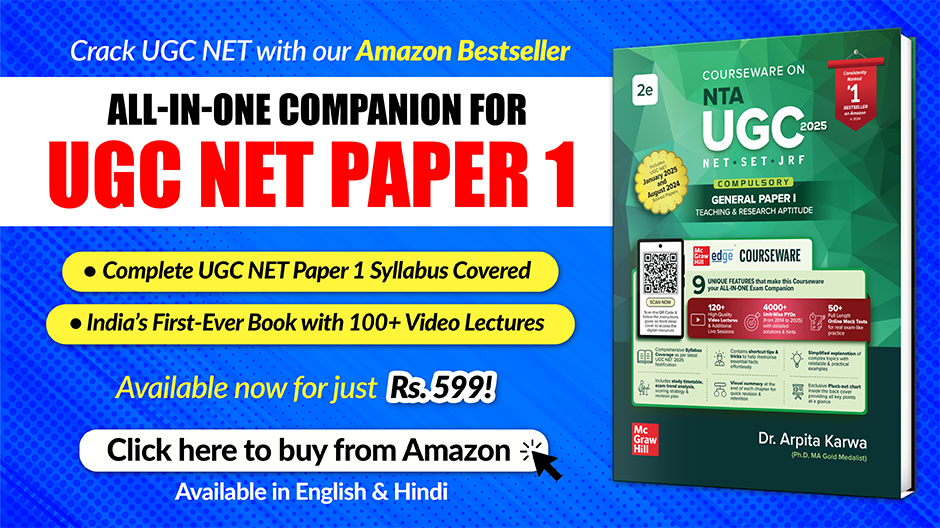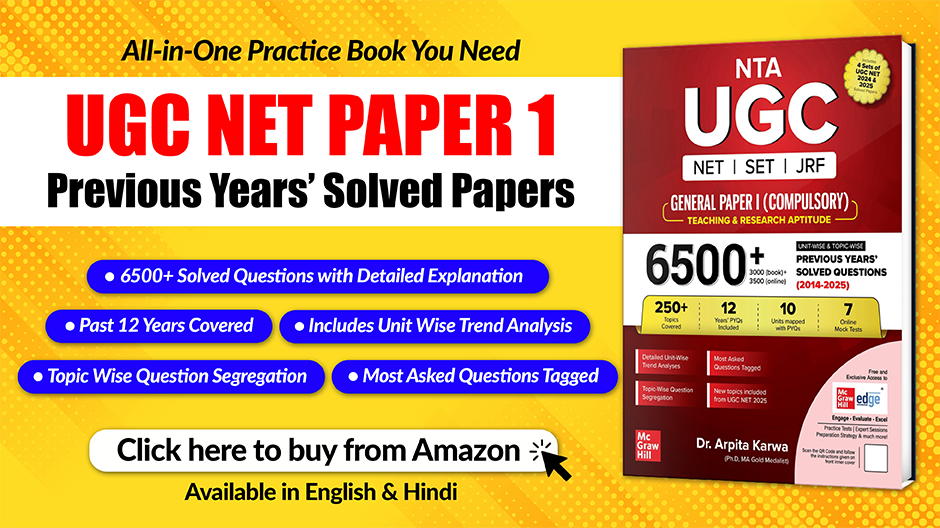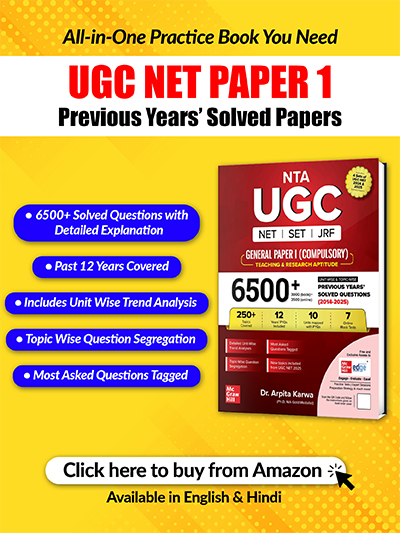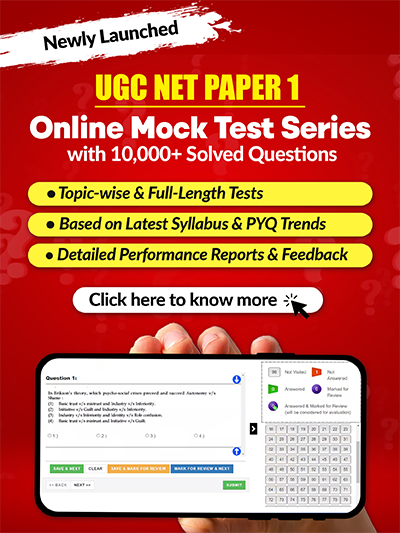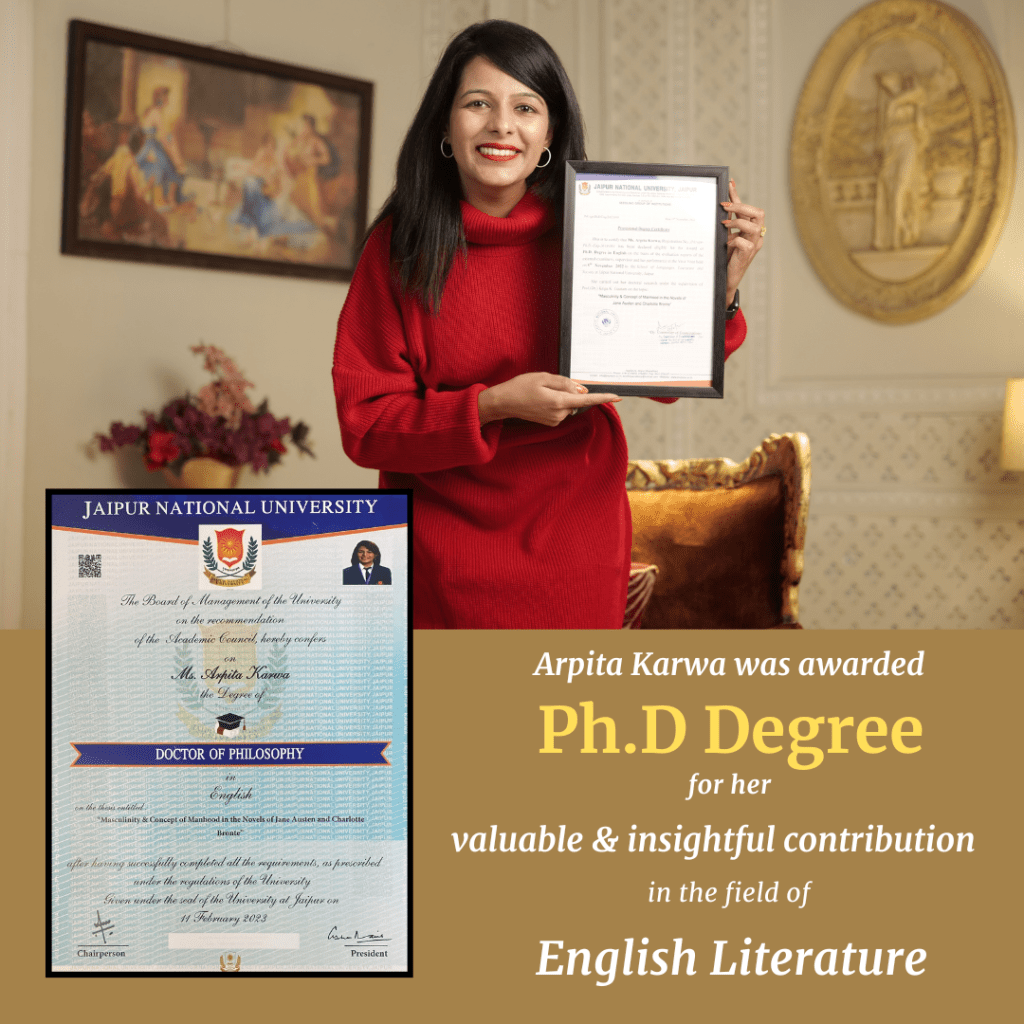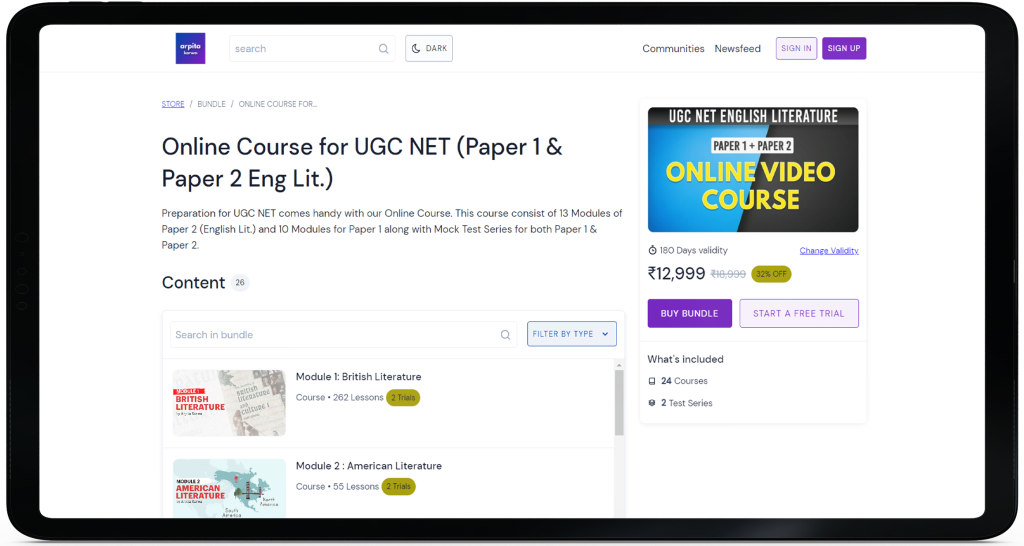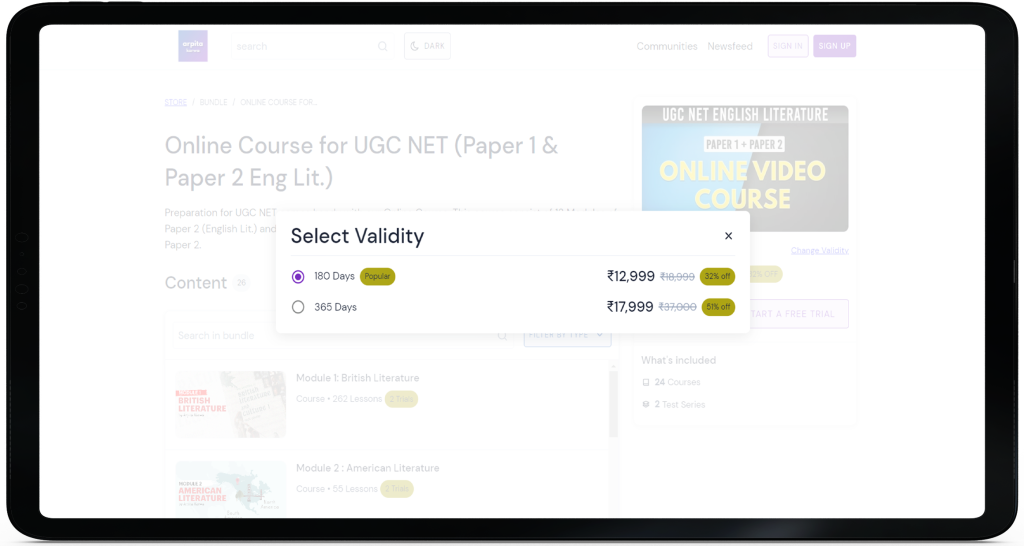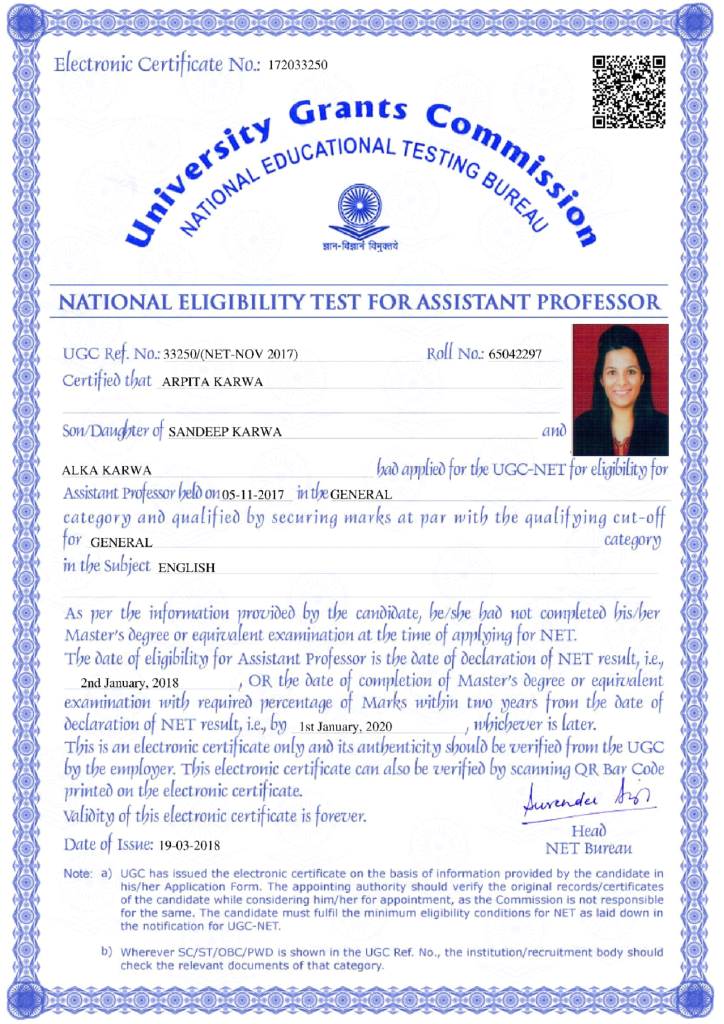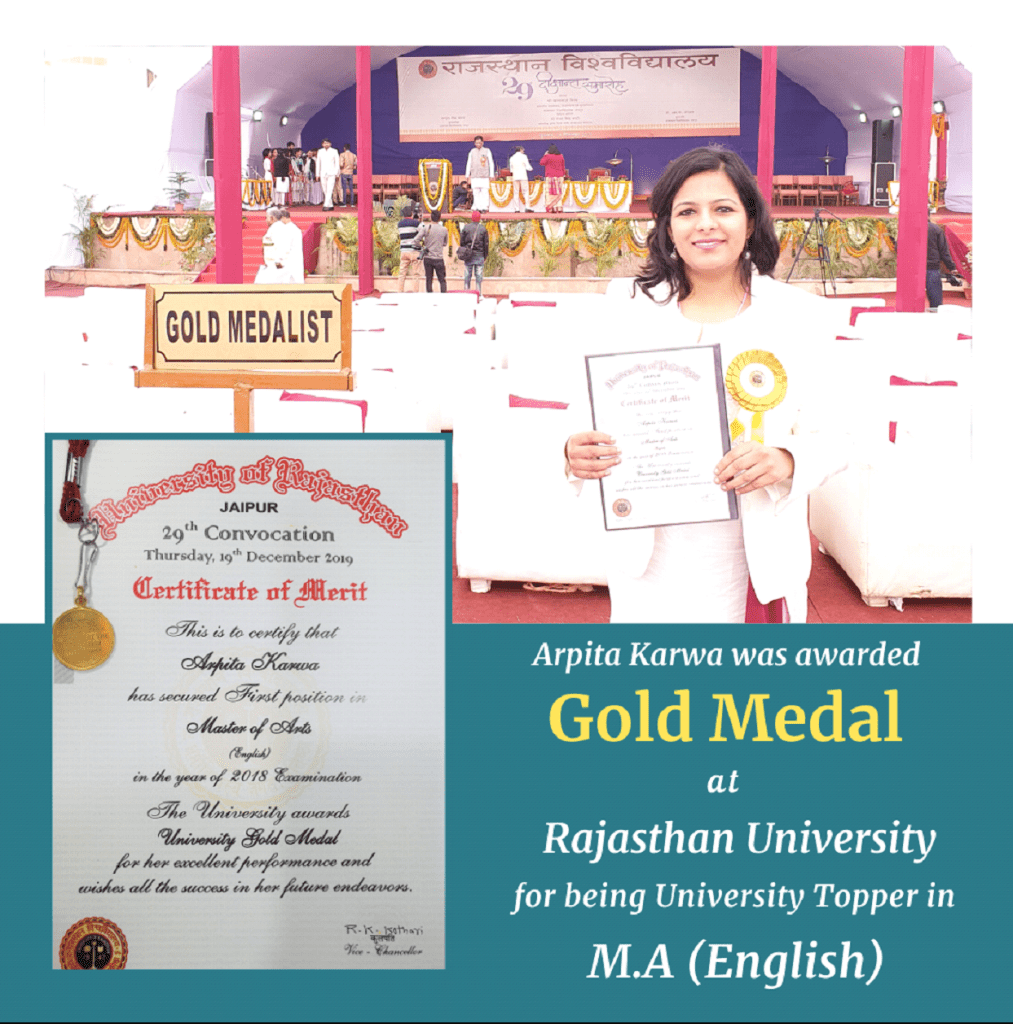UGC NET Paper 1 September 2020 (Conducted on 29th Sep 2020 : Evening Shift)
October 18, 2022 2025-08-18 13:41UGC NET Paper 1 September 2020 (Conducted on 29th Sep 2020 : Evening Shift)
September 2020: Paper 1 (Conducted on 29th Sep 2020 : Evening Shift)
Q.1-5)
Q.1) In case all the girls in the department ‘A” donated blood, then the number of boys in the department ‘A’ who did not participate in the blood donation camp is
[1] 32
[2] 48
[3] 60
[4] 56
Correct Answer: 2
Q.2) The number of students who donated blood in the department ‘C’ is
[1] 39
[2] 91
[3] 130
[4] 169
Correct Answer: 3
Q.3) The number of girls in the department ‘A’ who donated blood is
[1] 32
[2] 130
[3] 55
[4] 48
Correct Answer: 1
Q.4) If 45 boys from the department ‘B’ did not donate blood, then the total number of students in the department ‘B’ is
[1] 120
[2] 150
[3] 80
[4] 200
Correct Answer: 4
Q.5) What is the ratio of the number of blood donors in the department ‘A’ compared to the number of blood donors in B ?
[1] 1:5
[2] 2:5
[3] 9:16
[4] 8:15
Correct Answer: 4
Q.6) If your students are identified as ‘Unable but willing’ in terms of their performance readiness level, which of the following methods of teaching will be considered appropriate to deal with them?
[1] Giving challenging tasks during teaching
[2] Providing scope for sharing responsibility and recognition
[3] Mentoring and guiding with close supervision
[4] Small step presentations with error free tasks and frequent reinforcement
Correct Answer: 4
Q.7) Identify from the following list of competencies of teaching, those which are related to personality and attitude
A. Managing
B. Monitoring
C. Locus of control
D. Planning
E. Self-efficacy
[1] AB
[2] BC
[3] CD
[4] CE
Correct Answer: 4
Q.8) Match the column:
List-1: Assessment and test interpretation methods:
A. Formative assessment
B. Summative assessment
C. Norm-referenced testing
D. Criterion-referencing testing
List-2: Description
I. The test data help us to determine a student’s rank
II. The test data tell us about a student’s level of proficiency
III. The intention in the evaluation is to identify scope for improvement
IV. Evaluation is in the form of judgement to be used for at least immediate future
[1] A-I B-II C-III D-IV
[2] A-III B-IV C-I D-II
[3] A-IV B-III C-II D-I
[4] A-II B-I C-IV D-III
Correct Answer: 2
Q.9) A university teacher proposes a research project on ‘why parents are apathetic to the university programmes’. Which of the following research methods will be most appropriate for the project?
[1] Experimental method
[2] Historical method
[3] Participant-observation method
[4] Ex post facto method
Correct Answer: 3
Q.10) This level of teaching offers the best opportunity for cognitive interchange, where students use skills like analysis (breaking down ideas into parts) and synthesis (putting parts together to form new ideas). At the reflective level, students think critically, ask questions, and connect different pieces of information. This encourages deep understanding and helps them develop more complex thinking skills, beyond just remembering or understanding facts.In which level of teaching there is optimum scope for cognitive interchange requiring analysis and synthesis?
[1] Memory level teaching
[2] Understanding level teaching
[3] Reflective level teaching
[4] Autonomous development level teaching
Correct Answer: 3
Q.11) Statement I: Reliability is a necessary but insufficient condition for the validity aspect of a research tool
Statement Il: Validity is threatened when a test measures only the construct it is designed to measure in a research
[1] Both Statement I and Statement II are correct
[2] Both Statement I and Statement II are incorrect
[3] Statement I is correct but Statement II is incorrect
[4] Statement I is incorrect but Statement II is correct
Correct Answer: 3
Q.12) Identify the features of scientific method from the following list
A. Clearly defined variables and procedures
B. Empirically verifiable hypotheses
C. Little or no scope for self-correction
D. Linguistic justification of conclusions
E. Ability to rule out rival hypotheses
[1] ABE
[2] BCD
[3] CDE
[4] BDE
Correct Answer: 1
Q.13) From the point of view of research ethics which of the following is least vulnerable in research?
[1] Problem-formulation and identifying the variables involved
[2] Data analysis and interpretation
[3] Reporting of research result and their implications
[4] Citing a theory in support of one’s thesis
Correct Answer: 1
Q.14) Which of the following sampling methods in research are non-probability based?
A. Cluster sampling method
B. Dimensional sampling method
C. Random sampling method
D. Judgement sampling method
E. Snowball sampling method
[1] BCD
[2] ABC
[3] BDE
[4] CDE
Correct Answer: 3
Q.15) Communication stimuli used to convey the message are known as
[1] Process
[2] Power
[3] Channel
[4] Codes
Correct Answer: 4
Q.16) Communication activities of learners fall into domains consisting of
A. Perception
B. Groupism
C. Inter-personal skills
D. Regressive behavior
E. Inter-personal relations
[1] ABC
[2] ACE
[3] ACD
[4] ADE
Correct Answer: 2
Q.17) Assertion A: New media enhance the opportunities to expand the learning environment unheard of before
Reason R: Learners can design their own learning process
[1] Both A and R are correct and R s the correct explanation of A
[2] Both A and R are correct but R is NOT the correct explanation of A
[3] A is correct but R is not correct
[4] A is not correct but R is correct
Correct Answer: 1
Q.18) The sequence of elements in linear model of communication is
A. Message
B. Decoder
C. Encoder
D. Medium
E. Noise
[1] ACBED
[2] BDCAE
[3] CADEB
[4] DECAB
Correct Answer: 3
Q.19) Match the column:
A. poor listeners
B. aggressive listeners
C. positive listener
D. pseudo-intellectual listeners
I. Scold others
II. Easily agree wit the speaker
III. Listen to ideas not understandingn emotions
IV. Fridge compulsively
[1] A-I B-II C-III D-IV
[2] A-II B-III C-IV D-I
[3] A-III B-IV C-I D-II
[4] A-IV B-I C-II D-III
Correct Answer: 4
Q.20) A train is traveling at a speed of 96 kilometres per hour. It takes 3 seconds to enter a tunnel and 30 seconds more to pass through it completely. Which of the following statements are correct?
A Length of the tunnel is 100 meters
B. Tunnel is longer than train
C. Train is longer than tunnel
D. Length of the train is 80 meters
E. Length of the tunnel in 800 meters
[1] ACD
[2] AB
[3] CD
[4] BDE
Correct Answer: 4
Q.21) The difference between the ages of two men is 10 years. 15 years ago, the elder one was twice as old as the younger one. The present age of the elder man is
[1] 25 years
[2] 35 years
[3] 45 years
[4] 40 years
Correct Answer: 2
Q.22) Match the column:
A. HCF
B. LCM
C. Product
D. Sum
I. 672
II. 8064
III. 180
IV. 12
[1] A-I B-IV C-III D-II
[2] A-I B-IV C-II D-III
[3] A-II B-IV C-I D-III
[4] A-IV B-I C-II D-III
Correct Answer: 4
Q.23) Statement : A number is divisible by 25, if the number formed by its last two digits is either (00) or divisible by (25)
Statement II: A number is divisible by 16, if the number formed by its last 4 digits is divisble by 16
[1] Both Statement I and Statement Il are true
[2] Both Statement I and Statement Il are false
[3] Statement I is true but Statement Il is false
[4] Statement I is false but Statement Il is true
Correct Answer: 1
Q.24) Match the column:
A. Triangle area
B. Square area
C. Rhombus area
D. Parallelogram area
I. Base x height
II. 1/2 x (product of diagonals)
III. 1/2 x base x height
IV. (Side)^2
[1] A-II B-IV C-I D-III
[2] A-III B-IV C-II D-I
[3] A-III B-IV C-I D-II
[4] A-II B-III C-I D-IV
Correct Answer: 2
Q.25) All flowers are toys. Some toys are trees. Some butterflies are trees, then
A. No butterfly is flower
B. Some butterflies are toys
C. Some toys are flowers
D. Some trees are flowers
E. Some trees are butterflies
[1] AB
[2] CE
[3] BE
[4] BD
Correct Answer: 2
Q.26) “Wherever there is smoke, there is fire.
There is smoke in Mr Verma’s chamber.
There must be fire in Mr Verma’s chamber.”
In accordance with Indian logic, this is an example of
[1] Pratyaksha pramana (Perception)
[2] Upmana (Comparison)
[3] Hetvabhasa (Fallacy)
[4] Vyapti (invariable relations)
Correct Answer: 4
Q.27) In order to authenticate the environmental values as advocated by our ancestors, ascholar cites examples from Vedas. The means of knowledge used by him/her in terms of Indian logic will be called
[1] Anumana (inference)
[2] Arthapatti (Implication)
[3] Shabda (Verbal testimony)
[4] Upamana (Comparison)
Correct Answer: 3
Q.28) In the series B, D, H, J, N, P, .. What will come after P?
[1] U
[2] S
[3] R
[4] T
Correct Answer: 4
Q.29) If LIGHT is written as GILTH and FIGHT is written as GIFTH, then SIGHT will be written as
[1] GISHT
[2] GISTH
[3] GSITH
[4] GSIHT
Correct Answer: 2
Q.30) GUI stands for
[1] Graphical Usage Interaction
[2] Gaming User Interface
[3] Graphical user Interface
[4] Graphical User Interaction
Correct Answer: 3
Q.31) Statement I: Operating systems are hardware
Statement II: Algorithm is a step by step procedure to solve a problem
[1] Both Statement I and Statement Il are true
[2] Both Statement I and Statement II are false
[3] Statement I is correct but Statement Il is false
[4] Statement I is incorrect but Statement Il is true
Correct Answer: 4
Q.32) Statement I: Compilers are software
Statement II: Touch screen monitors are input/output devices
[1] Both Statement I and Statement Il are true
[2] Both Statement I and Statement Il are false
[3] Statement I is true but Statement Il is false
[4] Statement I is false but Statement Il is true
Correct Answer: 1
Q.33) Match the column:
A. image
B. video
C. audio
D. word processing
I. .doc
II. .mp3
III. .jpeg
IV. .mpeg
[1] A-I B-II C-III D-IV
[2] A-III B-IV C-II D-I
[3] A-II B-III C-IV D-I
[4] A-I B-IV C-III D-II
Correct Answer: 2
Q.34) Match the column:
A. search engine
B. job openings
C. e-mail
D. e-commerce
I. www.gmail.com
II. www.amazon.in
III. www.google.com
IV. www.naukri.com
[1] A-III B-IV C-I D-II
[2] A-IV B-III C-I D-II
[3] A-I B-II C-III D-IV
[4] A-I B-III C-II D-IV
Correct Answer: 1
Q.35) Identify the correct sequence of countries contributing to global CO2 emission in decreasing order from fossil fuel burning, cement manufacturing and gas fairing in the year 2014:
A. USA
B. EU-28
C. China
D. Russia
[1] CABD
[2] ACBD
[3] ABCD
[4] ACDB
Correct Answer: 1
Q.36) Which among the following are used as semiconductor materials to fabricate solar cells
A. Silicon (Si)
B. Tin oxide (SnO)
C. Cadmium Sulphide (CdS)
D. Gallium Arsenide (GaAs)
[1] AC
[2] AB
[3] BCD
[4] ABCD
Correct Answer: 4
Q.37) Which of the following is not a Sustainable Development Goal?
[1] Gender equity
[2] Climate action
[3] Protection of Ozone layer
[4] Life below water
Correct Answer: 3
Q.38) Match the column:
A. virus
B. bacteria
C. protozoa
D. helminths (parasitic worm)
I. cholera
II. schistosomiasis
III. hepatitis
IV. dysentery
[1] A-I B-III C-IV D-II
[2] A-I B-III C-II D-IV
[3] A-III B-I C-II D-IV
[4] A-III B-I C-IV D-II
Correct Answer: 4
Q.39) Which among the following are emitted from a coal-based thermal power plant?
A. Carbon monoxide
B. Ozone
C. Sulphur dioxide
D. Methane
E.Particulate matter
[1] ABCE
[2] ACE
[3] ABC
[4] ACDE
Correct Answer: 2
Q.40) Statement I: The three greatest challenges facing higher education in India, described by FICCI (2012) are expansion, equity and excellence
Statement II: While ll three issues indicated in Statement I are inter-linked, equity to a large extent is dependent on expansion and access
[1] Both Statement I and Statement Il are true
[2] Both Statement I and Statement Il are false
[3] Statement I is correct but Statement Il is false
[4] Statement I is incorrect but Statement Il is true
Correct Answer: 1
Q.41) Which of the following are regulatory bodies within the Department of Higher Education in the Ministry of Human Resource Development in the Central Government?
A. NUEPA
B. UGC
C. AICTE
D. DEC
E. ICSSR
[1] BCD
[2] ABC
[3] CDE
[4] ADE
Correct Answer: 1
Q.42) Identify from the following, features which describe most appropriately the Indian values
A. Emphasis on individual ambition
B. Emphasis on collectivism
C. Emphasis on social progress
D. Emphasis on social stability
E. Emphasis on unity in diversity
[1] ABC
[2] BCD
[3] CDE
[4] BDE
Correct Answer: 4
Q.43) Statement I: The UGC in India has statutory responsibility for maintenance of quality and coordination of institutions of higher education
Statement II: The NCTE being a regulatory body for teacher education in India comes under the control of UGC
[1] Both Statement I and Statement Il are true
[2] Both Statement I and Statement Il are false
[3] Statement I is correct but Statement Il is false
[4] Statement I is incorrect but Statement Il is true
Correct Answer: 3
Q.44) In university governance, who is the executive head?
[1] The Chancellor
[2] The Vice-Chancellor
[3] The Registrar
[4] The Education Secretary
Correct Answer: 2
Q. 45-50)
Read RC Passage to Answer:
At the turn of the century, a dominant conception of the child as learner was that he was cognitively an “empty organism” responding more or less randomly to stimulation, and characteristically leaming when specific responses were connected with specific stimuli through the meditation of pleasure or pain. The organism itself, it was believed, would do nothing to learn or think if it were not impelled to such activity by primary drives like hunger or thirst or by extemally applied motives like reward and punishment. Experimenters in the laboratory were connecting the correct responses of animals to puzzle boxes by giving or withholding food and teachers in the classroom were connecting correct responses of children to problem cards by giving or withholding approval.
In pointing to this aspect of the tum-of-the-century view of the learner, I do not mean to derogate the historic achievement of the connectionist formulation of leaming. But the essential point remains, a conception of the learner as an ideationally empty organism associating discrete stimuli and responses through the operation of rewards and punishments under the control of the teacher. Both the stimulus – what was supposed to be learned – and the response – what was actually learned – were believed to be determined by the teacher.
It was no accident that the materials and methods of instruction and the form of the classroom were teacher-centered. The teacher was necessarily placed in front of the classroom – sometimes on a dais or platform – and the pupils in chairs rigidly fastened to the ficor in straight rows facing forward so they would not turn away from the only source of the learning experience: the teacher. Given this contemporary vision of the leader, what could be a more eminently practical and sensible image of the ideal learning environment? Indeed, there is a letter by John Dewey dating from this period in which he complains that when he was trying to equip his new school according to his different conception of the child as a learner, he was unable to find any other kind of classroom furniture.
Q.45) The early child was thought of as-
[1] Intelligent enough to know both pain and pleasure
[2] Having no power of cognition
[3] Not amenable to specific stimuli
[4] Having motivational effect in a random way
Correct Answer: 2
Q.46) The basic idea behind laboratory experiment was related to-
[1] Motivating the child with reward and punishment
[2] Considering hunger and thirst as negligible in impact
[3] Animals and children having the same drive
[4] Teachers controlling children
Correct Answer: 1
Q.47) The connectionist formula placed importance on-
[1] Withholding negative stimuli
[2] Teacher-centric motivation
[3] Search for specific responses
[4] Doing experiments in laboratories
Correct Answer: 2
Q.48) What was expected of pupils during those early days?
[1] To create an ideal leaming environment
[2] To be in the forefront of the classroom
[3] Be attentive towards classroom teaching
[4] To place the teacher on the higher pedestal
Correct Answer: 3
Q.49) What did John Dewey say of child learning?
[1] Teacher as the only source of knowledge
[2] The learner should be given incentives for learning
[3] The existing educational environment was ideal
[4] The focus should be on child as a learner
Correct Answer: 4
